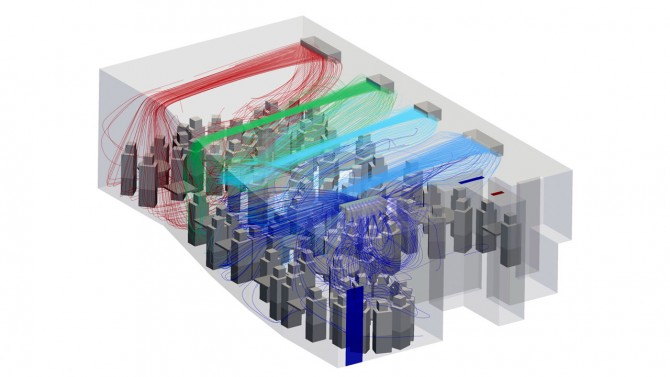Software tool breathes life into post-COVID office airflow
By Blaine Friedlander
As offices nationwide spring back to life, interior space designers and architects will soon have an easy-to-use planning tool to put indoor workplace furniture, staff and partitions – quite literally – in their proper place.
The Cornell Environmental Systems Lab in the College of Architecture, Art and Planning will introduce a new indoor module for their existing Eddy3D software, a professional-level airflow and microclimate simulator that can help improve ventilation.
The tool will be released this summer, while the research supporting it will be presented at the International Building Performance Association conference this September in Belgium.
The research stemmed from the realization of Zoe De Simone, B.Arch ’22, a Hunter R. Rawlings III Cornell Presidential Research Scholar and researcher in the Environmental Systems Lab; doctoral student Patrick Kastner; and Timur Dogan, assistant professor in the Department of Architecture, who directs the lab – that little information existed on virus transmission in indoor space and restaurants – and that indoor air quality and particle movement had been underexplored.
“The new indoor module for Eddy3D will show you how to configure furniture and desks, proper positioning of partitioned walls and how to maximize predictive ventilation to facilitate moving fresh air and impede airborne pathogens,” Dogan said.
Based on computational fluid dynamics, the tool features a simple user interface, a validated simulation engine and streamlined simulation setup for a fast analysis. It shows the eddies of air flow and can indicate regions in rooms where air is stagnant and pathogens begin to concentrate. The software can run on Windows, Rhinoceros and Grasshopper platforms – common in the architectural world.
The lab’s research show that furniture – and people – have a large influence on virus diffusion throughout the floor plan. Plastic partitions can block the virus diffusion, but direct air allows a higher virus dissipation rate.
“As a designer or an architect, it’s very difficult to develop an intuition for airflow,” Dogan said. “With this, you are getting a good synchronization of airflow everywhere, so that you’re not mixing or transporting bad air from one location to another, or from one desk to another.”
Without airflow knowledge, Dogan said that well-intentioned designs can sometimes reduce indoor fresh air. “If you put everyone into a space and add a partition wall, that may stop some contaminated air moving from one seat to another,” he said. “But it may make the indoor air quality problematic for the entire office.
“Here, we are taking intuition out of the equation,” Dogan said.
A preprint of the September research presentation work is available on ResearchGate. The presentation’s other is doctoral student Patrick Kastner, whose thesis is based on Eddy3D.
The paper and subsequent presentation in September adds to discourse on how interior design architecture may provide a direct and tangible effect on health.
“For me as an undergraduate student, I had the challenging opportunity to connect published medical field data with an architectural simulation – acting as a mediator between disciplines,” De Simone said. “I got to work on the development of an actionable tool from early-stage ideation to product release. Safer spaces can be planned.”
Architects and designers are not necessarily experts in computational fluid dynamics, Dogan said. “The goal is to help professionals make decisions about workplace and classroom environments.”
“It’s crucial to understand viral spread in indoor spaces,” Kastner said. “This doesn’t have to be used exclusively for offices or classrooms – it can be used to model any indoor space.”
Said Kastner: “It’s our hope that decisions – with the help of the new module – are better than the results made without this instrumental information.”
In addition to the authors, Remy Mermelstein, B.Arch ’22, conducted component validation of Eddy3D and Khaled Hashad, a doctoral student in the Sibley School of Mechanical and Aerospace Engineering in the College of Engineering, consulted with the group on particle deposition.
The Cornell Atkinson Center for Sustainability funded the research.
Eddy3D – currently without the new module – is available now for free. The new module will be available July 30.
Media Contact
Get Cornell news delivered right to your inbox.
Subscribe

